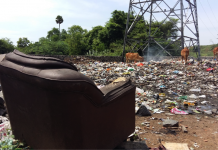My problem is present all around India and maybe across the world too, and it must have been present for centuries now. During the British Rule in India, there were not many rules regarding the criminal offences of littering in public. Although there may have been a few rules formed regarding this problem after India gained independence, this problem is very negligible by both government official and the general public. But the problem which I have decided to focus upon originated in my area just about 7 years ago, when the OMR (Old Mahabalipuram Road) was just constructed. Before the OMR was constructed, the area was not very much urbanized, thus not many people lived in the area. This lead to almost no garbage thrown in public.
But then after the OMR was built, there was a rapid process of urbanization in the area, which led to many new construction projects to spring up, thus drawing a large number of people for construction jobs.

Because of this rapid drawing of people, a slum was created in the area. And due to this slum (and also due to an apartment complex) there were many shops which were set up in the area. Because of the slum and the shops a large amount of waste was generated and it was improperly disposed in the public(i.e, the roads).

There are quite a few possibilities to how the area could be in the future:
One: Awareness is spread throughout the area regarding how much damage litter carelessly is potential of. Because of this there will be a further two possibilities:
- Litter is now not thrown carelessly; there is a sustainable method of disposing the waste
- Litter is now not thrown carelessly for a short period of time; after that people go back to their old ways due to laziness or any other such quality.
- People ignore the awareness campaign; people continue throwing litter in public
Two: The area will be filled with garbage. There will be a lot of problems such as:
- A large number of diseases, such as malaria, dengue, hepatitis, yellow fever, etc., will be present in the area due to many mosquitoes breeding in the stagnant water caused due to inappropriate disposal of garbage.
- The area will be smelling and will be visually unappealing, thus it will not attract further businesses into the area, which then leads to poor development of the area and causing losses to the area’s workers.
- Etc.
The main reason to why this problem occurs is due to negligence of the residents of the slum and the shopkeepers in the area.In the end these are the people who will be mainly affected by the problem.The government too is responsible for this problem as it is not being responsible in maintaining staff to clean the area in at least a twice-in-a-week basis.Also various animals like cows and dogs are part of this problem as they eat the garbage and they also spread it around. Plants to get affected by litter in ways like contamination, growth restriction, inhibition of nutrient uptake-all which causes stunted growth and eventually, in most cases, death of the plant.
When compared to a More Economically Developed Country, such as Singapore; India falls back in many ways. Singapore has many ways to tackle littering. For example Singapore’s littering fines are extremely high as they reach up to $2000. The court may also order the offender to work in community service for approximately 12 hours. There is also an agency; NEA (National Environment Agency) which educates and spreads awareness, through roadshows and other such activities, about social problems like littering on the road. Apart from this the Singapore government also ensures that garbage is collected from every house, every day and Singapore has about 6000 litter bins. Singapore also burns about 50% of the waste, which is then converted into fuel.

We could take inspiration from these innovative ways and implement them in India.






